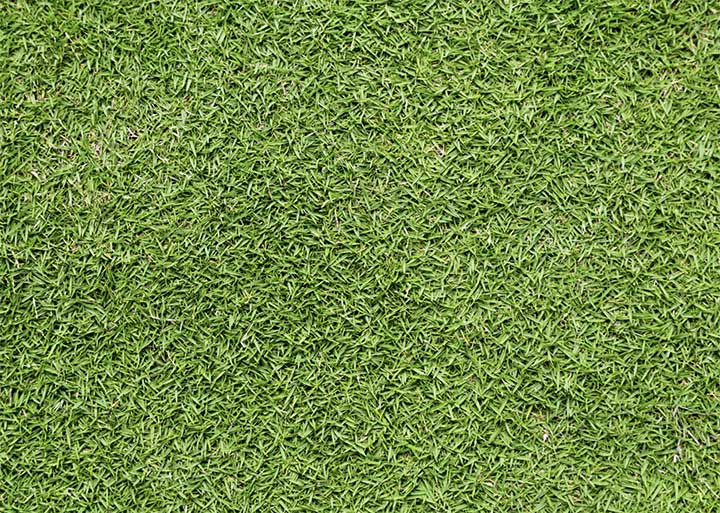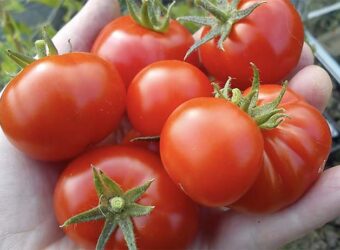Bermuda grass is native to Africa. It is grown across the southern United States as a lawn grass and on stadium lawns and golf courses. Bermuda grass requires fertilization several times a year to look its best.
Here are the best fertilizers for your Bermuda grass.
Best Bermuda Grass Fertilizers
Different fertilizers meet different needs. Here are my picks for the best fertilizers in the most common types you might choose.
1. Miracle-Gro® Water Soluble Lawn Food – Best Bang for the Buck

Miracle-Gro Water Soluble Lawn Food, 5 lb works well for small and medium-sized lawns.
There are four premeasured packets inside the container, each of which will treat 1,800 square feet. Simply drop the packet in a hose-end sprayer and put the lid on. Turn on the water and out comes the fertilizer.
Apply every four to six weeks for the best results. This fertilizer has an NPK ratio of 30-0-6. The extra potassium will help make your grass vigorous and resist diseases.
The container is sturdy enough to last all year. This fertilizer is formulated to work best with Miracle-Gro Garden Feeder, which is sold separately.
However, Miracle-Gro Water Soluble Lawn Food alone can green up a yellow lawn and help fill in dead spots with healthy grass.
I use this fertilizer when I fertilize Bermuda grass on high-phosphorous soils. As long as you use it as directed, this fertilizer won’t burn your grass.
Pros:
- Premeasured packets
- Dissolves easily in water
- Durable container to last all season
- Good for high-phosphorous soils
- Won’t burn the grass if used as directed
Cons:
- Works best with Garden Feeder, which is sold separately
2. Simple Lawn Solutions Lawn Energizer Micronutrient – Best With Sprayer

Simple Lawn Solutions Lawn Energizer Micronutrient comes premixed and ready to attach to your hose. This fertilizer provides nitrogen, iron, and micronutrients for your lawn.
Simple Lawn Solutions is an American company that makes this fertilizer in the United States. One container covers 3,200 square feet of lawn.
The NPK ratio is 6-0-0, making this an excellent fertilizer to add nitrogen to your lawn after green-up. The micronutrients and iron improve the fertility of the soil and keep your grass growing at its best.
I use Simple Lawn Solutions Lawn Energizer Micronutrient to deepen the color of my Bermuda grass and thicken its growth.
When using, I take care to spray the fertilizer on every bit of my lawn so it all gets the benefit of the fertilizer.
The iron in this product will stain fences and pavement, so be careful not to get fertilizer on those places.
After spraying, I wait fifteen minutes and then water the lawn. Save the sprayer because you can get a gallon refill for it, saving you money.
Pros:
- Comes ready to use
- Has iron and micronutrients
Cons:
- Limited coverage, so becomes pricey
- Will stain fences and pavement
3. Milorganite 0636 Organic Nitrogen Fertilizer – Best Organic Fertilizer

Milorganite 0636 Organic Nitrogen Fertilizer 32-Pound is a good organic fertilizer for Bermuda grass. It has an NPK ratio of 6-4-0, which has more phosphorus than usual.
However, that is because this is made of composted manure in a slow-release form. This fertilizer will not harm aquatic life.
Milorganite 0636 Organic Nitrogen Fertilizer has organic matter in it that improves your soil and feeds beneficial microorganisms.
I would not use it on turf grass growing in soils with a lot of phosphorous in them. Some states have a ban on phosphorus fertilizers for lawns, so Milorganite 0636 Organic Nitrogen Fertilizer 32-Pound can’t be used in these states.
Although this is an organic fertilizer, it is not certified organic so can’t be used in organic gardening.
Milorganite 0636 Organic Nitrogen Fertilizer helps lawns stay green even in high heat and drought conditions.
This fertilizer won’t burn your grass if applied as directed. Deer and rabbits don’t like the smell and don’t eat the grass unless there is really nothing else to eat.
I use a spreader to apply this fertilizer every eight to ten weeks. One bag covers 2,500 square feet of grass. I water the lawn well after spreading the fertilizer to activate it.
Pros:
- Contains no salt
- Promotes a strong root system
- Can deter deer and rabbits
- Won’t burn grass if used as directed
Cons:
- Strong smell when first applied
- Not certified organic
- Contains phosphorous
4. Simple Lawn Solutions Maximum Green High Nitrogen – Best Nitrogen Fertilizer

Simple Lawn Solutions Maximum Green High Nitrogen has an NPK ratio of 28-0-0 to give your lawn a burst of growth and color. The fertilizer is 70 percent quick release and 30 percent slow release, so feeds your grass between fertilization.
The quick-release fertilizer makes the lawn green up quickly while the slow-release fertilizer helps keep it green between fertilization.
The hose end sprayer covers 3,200 square feet of lawn. The fertilizer contains food-grade ingredients that really help your lawn. It is safe for pets after it is spread.
I use this fertilizer if my lawn has a nitrogen deficiency, slow growth, or sparsity to get my lawn to fill in and grow thickly. I spray it over my lawn.
Pros:
- Feeds lawns for a long time
- Convenient hose end sprayer
- Helps green up with high nitrogen level
Cons:
- Covers a small area per container
5. The Andersons Professional PGF Complete 16-4-8 Fertilizer – Best Pelleted Fertilizer

The Andersons Professional PGF Complete 16-4-8 Fertilizer with 7% Humic DG has an NPK of 16-4-8 and includes humic and fulvic acid. These improve the soil, balance the pH, and feed beneficial microorganisms.
This fertilizer is a mixture of fast and slow release, so you will see a change in your lawn quickly that lasts up to eight weeks.
I would not use this fertilizer with a lawn that is sick. I would use it to prevent problems in the future.
Before applying this fertilizer, I mow the lawn. I apply this fertilizer with a spreader onto a dry lawn.
After I am finished spreading the fertilizer, I water the lawn well. I apply it every six to eight weeks.
Pros:
- Very small pellets spread effectively
- Slow releasing so lasts long
- Ideal NPK ratio for Bermuda grass
- Good value for the money
Cons:
- Not effective for ailing lawns that need more nitrogen
- May not cover the 5,000 square feet on the label
6. Advanced 16-4-8 Balanced NPK – Best Liquid Fertilizer

Advanced 16-4-8 Balanced NPK – Lawn Food Quality Liquid Fertilizer is another good Simple Lawn Solutions product. The NPK ratio is 16-4-8 which is just right for Bermuda grass.
The nitrogen causes a quick green-up, the phosphorous encourages good roots, and the potassium encourages vigor in the grass.
I would use this product at green-up but not as the nitrogen fertilizer for spring and summer if you have a lot of potassium and phosphorous in your soil.
It also can’t be used in states that ban phosphorous lawn fertilizers. The fertilizer also includes micronutrients, fish, and seaweed to improve the soil.
Each container attaches to the end of the hose and treats 3,200 square feet of lawn.
I spray my lawn with the fertilizer. I started to see results in just one week.
Pros:
- Comes in a hose-end sprayer
- Complete fertilizer
- Includes micronutrients, fish, and seaweed to improve soil
Cons:
- May have too much phosphorous for some lawns
- Cannot be used where phosphorous is banned for lawns
7. Scotts Southern Turf Builder Lawn Food – Best Overall Fertilizer

Scotts Southern Turf Builder Lawn Food has an NPK ratio of 32-0-10. The nitrogen helps your lawn stay green and thick. The potassium helps the lawn stay vigorous and healthy even during drought.
It can be used in states that ban phosphorous lawn fertilizer and is less toxic to aquatic life. The fertilizer also enhances the lawn’s ability to absorb water and nutrients.
One bag covers 10,000 square feet. The lawn is safe to walk on right after spreading Scotts Southern Turf Builder Lawn Food.
The bag is difficult to seal once opened and the fertilizer can clump if the bag is not sealed well. You can burn your glass if you apply too much.
I apply it with a spreader and then water the lawn well. Because this fertilizer is slow-release, I only have to apply it every six weeks. It does take about a week to see noticeable results.
Pros:
- Covers a large area
- Works well during extreme heat
- Safe for kids and pets after spreading
- Phosphate free
Cons:
- The bag is difficult to seal once opened
- Can burn grass if you apply too much
How I Use These Fertilizers
At green-up, when the lawn is green and the threat of frosts is over, I spread Scotts Southern Turf Builder Lawn Food on my lawn. I use a walk-behind spreader, but you could use a hand spreader. In any case, I walk across the lawn in one direction north to south, then turn and walk across the lawn in another direction east to west. This assures my lawn gets the right amount of fertilizer all over.
About six weeks later, I start using Simple Lawn Solutions Maximum Green High Nitrogen or Simple Lawn Solutions Lawn Energizer Micronutrient. I just put the container on the end of my hose and spray my lawn. Every four to six weeks, I reapply this fertilizer until September, then I stop using fertilizer for the year. I use one of these particular fertilizers because my soil is high in phosphorus and potassium.
If I lived somewhere that did not have high levels of phosphorous and potassium in the soil, then I would use Advanced 16-4-8 Balanced NPK – Lawn Food Quality Liquid Fertilizer – Spring & Summer Concentrated Spray – Any Grass Type – Simple Lawn Solutions (32 Ounce) if I wanted to use a liquid, or The Andersons Professional PGF Complete 16-4-8 Fertilizer with 7% Humic DG if I wanted to use a pelleted fertilizer for my maintenance fertilizer.
Milorganite 0636 Organic Nitrogen Fertilizer 32-Pound is a good organic option, even though it is not certified organic. I would use it if your phosphorous soil levels are not high.
If you need potassium but not phosphorus, Miracle-Gro Water Soluble Lawn Food, 5 lb. Is a great option. I would use this as my maintenance fertilizer in that case.
Soil Tests
As you can see, you need to know if your soil is high in phosphorus or potassium to choose your fertilizer. The only way to do that is to have your soil tested. Your Extension agent or agricultural advisor can tell you how to do that. You get the results in a few weeks, and they contain the levels of nutrients and a recommendation for how much of what nutrients you need. In my area, adding nitrogen only even at green-up is recommended because of the high phosphorus and potassium levels in the soil.
Types of Fertilizer
Fertilizer comes in three different forms.
Liquid
Liquids work quickly because they are absorbed by the grass blades as well as the roots. You can see a greener color in twenty-four hours.
Because liquids deliver all their nutrients at once, you will have to reapply them more often. Liquids come in ready-to-use and concentrate. Many are sold in hose end sprayers you just connect to your hose and turn the water on to use.
Spray on fertilizers work well for small lawns as it is hard to reach all of a large lawn with a hose. For some sprays, you water your lawn after applying. Other sprays want you to wait to water. Look at the instructions on the container to see whether you water after applying the spray.
Granular
Granules are tiny pebbles that are used with a spreader. They often contain some quick-release and some slow-release fertilizers. Others only contain slow-release fertilizer. Slow-release fertilizer lasts longer but does not show results for about seven days after application. After application, you must water the lawn to activate the fertilizer.
Water Soluble
Sand-like particles are placed in a hose-end sprayer and dissolve as the water comes through. They allow you to water and fertilize at the same time. They work well in small yards where the hose can access the whole yard. Larger yards are harder to spray completely.
Organic versus Synthetic
There is a lot of debate about whether organic or synthetic products are better for the lawn.
Organic
All of the ingredients in an organic product are from nature. There is a difference between organic and certified organic, however. Certified organic products have gone through the certification process and proved that all of their ingredients are organic and on the approved ingredient list. Not all organic products are submitted and certified organic. Only certified organic products can be used in areas using organic gardening.
Synthetic
Synthetic products mean that one or more ingredients are created in a laboratory instead of by nature. Many synthetic products include ingredients made from petroleum. Many people claim synthetic fertilizers are bad for the soil, but scientists insist that is not true. Synthetic fertilizers can be expensive when petroleum prices go up.
How Do I Choose Bermuda Grass Fertilizer?
To some extent, that is a personal choice. Do you like to use a product that is sprayed on, or do you prefer to use a spreader? A sprayer only works well for small lawns because it is hard to reach all the parts of a large lawn with the hose. Spreaders don’t have that problem, so granular fertilizers work best on large lawns.
You need to look at the time of year and the amount of phosphorous and potassium in your soils to choose between a complete fertilizer or just applying nitrogen. In soils that do not have a high phosphorus and potassium content, you can use a complete fertilizer with an NPK ratio of 16-4-8 at green-up. However, if your soil has high levels of phosphorus and potassium, you should use nitrogen-only fertilizer. In some states, it is against the law to apply phosphorus to lawns, so you should use nitrogen-only fertilizer or one that contains nitrogen and potassium.
After green-up, most lawns should have a nitrogen fertilizer applied every four to six weeks until September. Using a fertilizer with phosphorus can often lead to a build-up of phosphorus, which interferes with the metabolism of iron and other nutrients.
Why Should You Fertilize Bermuda Grass?
Bermuda grass needs a lot of nitrogen to look its best. The dark color and rapid growth people plant Bermuda grass for are caused by plentiful nitrogen. Soils just don’t contain this much nitrogen without outside inputs. If you don’t fertilize, you will have yellowish grass that is thin and doesn’t grow well. Weeds will eventually out-compete your lawn and kill out the Bermuda grass.
When Do I Fertilize Bermuda Grass?
Climates With a Winter (Most Places)
You should fertilize your grass each spring when the grass turns green and there is little chance of a late frost. Use a fertilizer with a 3-1-2 ratio of nitrogen, phosphorous, and potassium. After that, apply one pound of soluble nitrogen per 1,000 square feet every four to six weeks through the end of August. Use a product that contains only nitrogen (21-0-0, for example) to avoid phosphorus buildup. Do not fertilize your Bermuda grass from September through February.
Climates That Are Warm All Year (I.e., Southern Florida, Southern Texas)
In April, fertilize your grass with a fertilizer that has a 3-1-2 ratio of nitrogen, phosphorus, and potassium. Every four to six weeks after that you need to apply one pound of soluble nitrogen per 1,000 square feet of lawn.
How Do I Fertilize Bermuda Grass?
There are two basic ways to fertilize Bermuda grass.
Hose End Sprayers
Hose end sprayers are attached to the end of the hose. You turn the water on and spray your lawn with fertilizer. It is important to cover the entire lawn because any grass that isn’t covered won’t benefit from the fertilizer. It is difficult to cover a large lawn because the hose rarely covers the entire lawn. Some fertilizers come in sprayers that you just hook up to the hose. Some liquid fertilizers require you to water the lawn after spraying them on, but some tell you not to water for a certain amount of time to allow the fertilizer to be absorbed by the grass blades. Follow the directions on the package for the best results.
Spreaders
Using a spreader to spread granular fertilizer works well with large lawns as well as smaller lawns. Most fertilizer bags tell you what number to set the spreader on to release the fertilizer at the proper rate. You can use a push-behind spreader or a handheld spreader. You will have to fill up a handheld spreader more often, but they are cheaper. Spread the fertilizer by walking back in forth from north to south until the entire lawn is treated. Then, walk back and forth from east to west until the entire lawn is treated again. After you spread the fertilizer, water the lawn well to activate the fertilizer.
Final Verdict
In conclusion, the best overall fertilizer for Bermuda grass is Scotts Southern Turf Builder Lawn Food.
If your soil has a lot of phosphorus and potassium, use Simple Lawn Solutions Maximum Green High Nitrogen or Simple Lawn Solutions Lawn Energizer Micronutrient both at green-up and as a maintenance fertilizer.
Make sure that when you fertilize, you cover the entire lawn. Remember that spray products that include iron will stain fences and pavement, so be careful where you spray. Some fertilizers require water to activate them.
Read the label directions to see if that is true of the one you are using. Manage thatch, mow correctly, and water the proper amount in addition to fertilizing correctly to keep your Bermuda grass lawn looking dark green and growing thick and lush.






